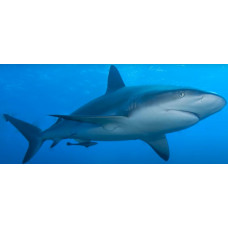Latin name
Carcharhinus perezi
Other names
Carcharhinus perezi
Identification
They have a strong, spindle-shaped body and a broad, rounded, short snout. The large mouth is arched with triangular serrated teeth. There are 22-26 rows of teeth on each jaw. The teeth have a broad base and end in a pointed mouth, narrower on the lower jaw. The edges of the teeth are serrated. The eyes are large and round, with a blinking membrane. Five pairs of gill slits are quite long, the third pair is located at the beginning of the base of the pectoral fins. The first dorsal fin is slightly sickle-shaped with a large curved posterior margin. The second dorsal fin is much smaller than the first. There is a small ridge between the dorsal fins. The base of the first dorsal fin is level with the end of the free posterior tips of the pectoral fins and the base of the second is anterior to the base of the anal fin. The sickle-shaped pectoral fins are well developed and taper towards the end. The tail fin is asymmetrical. Skin folds at the nostrils are absent. The dorsal surface of the body is grey-brown and the ventral surface is white or yellowish-white. Slightly conspicuous stripes run down the sides. There are no distinct markings on the fins, but the underside of the paired fins, anal fin and lower caudal fin blade are darker than the main background. The skin is densely covered with overlapping placoid scales.
Distribution
These sharks inhabit the tropical waters of North, Central and South America, with the largest distribution in the Caribbean waters of Florida, Bermuda, Yucatan, Cuba, Jamaica, Bahamas, Mexico, Puerto Rico, Colombia, Venezuela and Brazil. They are found in shallow waters, around coral reefs and on the edge of underwater cliffs at depths of up to 378 metres, rarely descending below 30 metres. Carcharhinus perezii is occasionally found in muddy areas in the deltas of Brazilian rivers.
Habitat
They are nocturnal. There is no seasonal variation in activity or migration. Juveniles of this species often have a limited individual habitat, while adults patrol large areas. Unlike most shark species, which need to move to allow water to pass through their gill slits to oxygenate their bodies, Caribbean reef sharks can lie motionless on the bottom, filtering water through their gill slits. When disturbed, the sharks become aggressive: their movements become abrupt, they change direction quickly and lower their pectoral fins for a few seconds.
Size
The average adult size is 152-168 centimetres. The maximum recorded length is 295 centimetres and the weight is 70 kilograms.
Life history and Behavior
In the Fernando de Noronha archipelago and Rokas Atoll in Brazilian waters, births occur at the end of the dry season from February to April, while elsewhere in the southern hemisphere females give birth during the rainy season in November and December.
Food and feeding habits
The diet consists mainly of a variety of bony reef fish, as well as cartilaginous fish such as Aetobatus and rays Urobatis jamaicensis. This species of shark is thought to prefer sick and injured fish. The shark uses its lateral line to detect low frequency sound vibrations, indicating the presence of suitable prey nearby. Juvenile sharks feed on small fish, shrimp and crabs. Caribbean reef sharks are able to regurgitate ingested food from their stomachs, probably to get rid of inedible particles, parasites and mucus that line their stomachs.
Reproduction
The Caribbean reef shark is a viviparous species, the embryos develop intrauterine, feeding on egg yolk, then the empty yolk sac is transformed into a placental connection through which they continue to be nourished. There are 4 to 6 newborns in a litter, up to 74 cm long. During copulation, the males often bite the females, leaving numerous highly visible scars on their skin. Pregnancy lasts 1 year. Males and females reach sexual maturity at lengths of 1.5-1.7 and 2-3 metres respectively.
Human interaction
Although listed as potentially dangerous to humans, these sharks do not pose a serious threat unless they are provoked to attack, such as when a person has an open wound or during underwater hunting. There have been a number of incidents involving this species of shark in the Bahamas. Most have occurred during underwater hunting. These sharks are harvested commercially and artisanally using longlines and gillnets. The meat, skin and liver fat are prized, and fishmeal is made from the carcasses. Their commercial harvest is prohibited in US waters.
| Classification | |
| Phylum | Chordata |
| Class | Chondrichthyes |
| Squad | Carcharhiniformes |
| Family | Carcharhinidae |
| Genus | Carcharhinus |
| Species | C. perezi |
| Features | |
| Conservation status | Endangered |
| Habitat | Pelagic |
| Life span, years | No information |
| Maximum body weight, kg | 70 |
| Maximum length, cm | 295 |
| Sailing speed, m/s | No information |
| Threat to people | Edible |
| Way of eating | Predator |
Caribbean reef shark
Tags: caribbean reef shark



